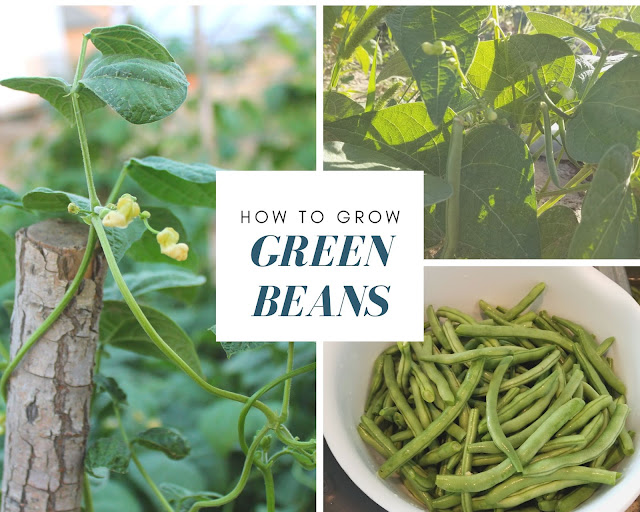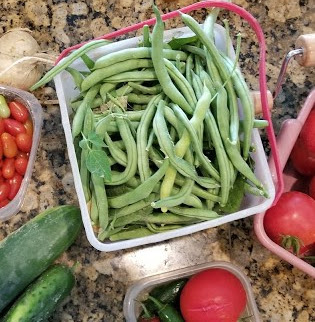Growing Green Beans for Beginners
Gardening is very rewarding. Tiny plants grow and yield delicious veggies that can be eaten for days, months, even years to come.
One of the easiest plants to grow are green beans. They are hearty, healthy and perfect for small or large families.
This post contains affiliate links to products we recommend. We do make a portion off any you may purchase. See full disclosure here.
With the proper knowledge and a few pointers, you can learn how to grow green beans with a high success rate and loads of beans to eat throughout the summer and into the fall.
Let's look at a few questions and get you sowing and growing your own green beans.
What type of green bean to plant?
This question really depends on where you live and how much garden space you are willing to give to green beans. However, we will talk about the two most popular types of green beans.
The first type of green bean are the bush beans. They are planted in rows with about 6" between plants. The do grow up but they don't vine out like pole beans.
It is smart to have some support for bush beans. We typically will stake a post at both ends of the rows and string 2 pieces of twine across. Just to give the bush beans something to hold on to.
Pole beans are the other type of green bean. They grow tall and have a vine like quality to them. They require a pole, trellis, or garden bean net to allow them to grow up and out.
How long does it take for green beans to grow?
Bush beans grow well in hot climates. They typically grow withing 45-60 days. They come on fast and then they are done.Pole beans are great for growing in more mild temperature summers. They take 55 to 65 days to develop and will last a bit longer on the plant than bush beans.
Do you need a trellis to grow green beans?
For pole beans, you will want a trellis or tall support for them to grow on. You can even plant them on a fence line and allow them to grow up the fence.
Bush beans don't need much support although a bit is good. It makes them easier to harvest.
How many green beans will one plant produce?
Most green bean plants will produce between 15 and 25 pods per plant.
To put that into perspective, our family cans green beans each summer. We plant between 30-40 bush bean plants. One harvest of beans can give us about 6 or 7 quart size jars of beans.
Something to remember is that all the beans won't be ready at the same time. That means you'll have to harvest daily or at least a couple times a week in order to get the full harvest benefits.
If you don't plan to can beans, you won't probably want as many plants. Just a handful can give you enough beans for soups, stews and stir frys.
How many green bean plants should I plant for my family?
It is suggested that you have between 4-8 plants per family member. For a family of four, you'd want 16-24 plants.
That would allow for some to eat and some to preserve. If you don't plan to preserve any, you can go with the lower number of plants.
How to plant green beans?
Sow the seeds right into the ground when the last frost has past. Green beans need warm soil to grow or they will mold. Full sun is best for growing green beans.
Sow them 1 inch deep into the ground and 4-6 inches apart.
Add supports like a trellis or fence for pole beans and string twine across rows for bush beans.
Water green beans 1.5-2 inches of water a week. If it is particularly hot, they will need more water.
We prefer to water using an irrigation method versus sprinklers over the top. Green beans do best with water right to the roots.
Harvesting Green Beans
Once the beans have started to come onto the plants, look for long and lean bean pods. You don't want them to be stringy but you also don't want them to be overgrown and fat. Usually you are looking for a nice "snap" when you pop the green bean open.You'll want to plan to harvest your beans daily or at least 2-3 times a week. If they get to large, they can become bitter and don't taste good.
To harvest, pinch the top of the bean right at the base of the connection to the plant. Pop them in a bowl or apron as you go.
If you plan to eat or can them right away, rinse them in cold water. Snap the ends and enjoy.
If you don't plan to use them right away, we suggest not cleaning them until you are ready to use. The water often makes them wilt or go limp and they aren't as good to eat.
Protecting Green Beans
Green beans aren't just popular with people. Many bugs and four legged creatures enjoy a good green bean crop as well. Here are a couple of ways to protect your plants and harvest.
If you have issues with rabbits or deer, you can try using garden cloches. They cover the plants as they are growing to keep pests from munching on the plants.
Keep the leaves up off the ground to prevent mold or mildew from hurting your crop. That is another reason why a trellis or stringing twine is important.
As for bugs, caterpillars, Mexican bean beetles, and aphids do enjoy a green bean treat. Make sure at the first sign of bugs you pinch them off or use the hose to blast them off with water.
Yes, there is a lot of information here about how to grow green beans. However, don't fret. Simply grab those seeds and sow them. You will learn what works best for your garden as you experiment and grow beans.
Just start growing!!













Comments
Post a Comment